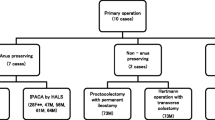Summary
48 surving male Wistar rats, which achieved a double loop colostomy at the descending colon, developed spontaneous adeno-carcinomas at the proximal orifice of the stoma within 120–200 days. To differentiate the importance of fecal passage and eversion of the colon, the descending colon was separated from the fecal stream by a colostomy at the ascending colon, splitted longitudinally and inserted in the abdominal wall. Adeno-carcinoma arose in both positions, mainly within 120 days. Colonic mucosa, thus exposed, predominates to maligne transformation. The preferred development of cancer at colostomies, as seen in systemically induced colonic cancer, is therefore explained to be of syncarcinogenic type. Similar lesions were found at human colostomies. The rareness of original carcinoma at human colostomies is caused by a more-years time of induction in relation to the high average age of patients getting a colostomy. In fact we regard this type of cancer as a biological phenomena comparable to the cancer of the gastric stump.
Zusammenfassung
Nach Anlage einer doppelläufigen Colostomie bei männlichen Wistar-Ratten entwickelten 48 überlebende Tiere nach 120–200 Tagen spontane Adenocarcinome am oralen Stoma. Zur Differenzierung der Bedeutung von Stuhlpassage und Vorlagerung wurde das durch doppelläufige Aszendostomie ausgeschaltete C descendens offen in die Bauchhaut eingenäht. Nach 120 Tagen waren sowohl am oralen Schenkel der Aszendostomie als auch am vorgelagerten C. descendens regelmäßige Adenocarcinome entstanden. Die derart exponierte Colonschleimhaut disponiert also zu maligner Entartung. Die Befunde erklären im Sinne der Syncarcinogenese die bevorzugte Lokalisation systemisch induzierter experimenteller Coloncarcinome an Colostomien. Analoge Beobachtungen können an menschlichen Kunstaftern gemacht werden. Die relative Seltenheit eines menschlichen Ap-Carcinoms sui generis ist angesichts mehrjähriger Indukationszeiten auf das hohe durchschnittliche Lebensalter zum Zeitpunkt der Ap-Anlage zurückzuführen.
Similar content being viewed by others
Literatur
Dahm, K., Werner, B.: Experimentelles Magenstumpfcarcinom. Ein Beitrag zur Pathogenese des Magenstumpfcarcinoms. Langenbecks Arch. Chir.333, 211 (1973)
Farris, E. J., Griffith, J. Q.: The rat in laboratory investigations. Philadelphia-London-Montreal: J. B. Lippincott Comp. 1949
Grasso, P., Creasey, M.: Carcinoma of the colon in a rat. Europ. J. Cancer5, 415 (1969)
Green, E. W.: Colostomies and their complications. Surg. Gynec. Obstet.122, 1230 (1966)
Kretschmer, K. P.: Der künstliche Darmausgang. Ostomien des Darmes. Stuttgart: Thieme 1975
Kuntzen, H., Pitzler, K.: Der Anus praeter naturalis und seine Komplikationen. Zbl. Chir.87, 67 (1962)
Lasser, A., Acosta, A. E.: Colonic neoplasms complicating ureterosigmoideostomy. Cancer35, 1218 (1975)
Löhrs, U., Wiebecke, B., Eder, M.: Morphologische und autoradiographische Untersuchungen der DarmschleimhautverÄnderungen nach einmaliger Injektion von 1,2-Dimethylhydrazin. Z. exp. Med.151, 297 (1969)
Loth, R.: Der Einfluß der Hemicolektomie auf die Ausbildung von Dickdarmtumoren nach subcutaner Injektion von 1,2-Dimethylhydrazin. Langenbecks Arch. Chir. (Suppl. Chir. Forum) 123 (1974)
Morson, B. C.: The polyp-cancer sequence in the large bowel. Proc. roy. Soc. Med.67, 451 (1974)
Navarrete, A., Spjut, H.: The effect of colostomy on experimentally produced neoplasms of the colon of the rat. Cancer (Philad.)20, 1466 (1967)
Otto, H. F., Winkler, R., Heitmann, C.: Tierexperimentelle Untersuchungen zur Morphogenese Nitrosamin-induzierter colo-rectaler Tumoren. Z. Krebsforsch. (im Druck, 1976)
Preissig, R.: The increased incidence of carcinoma of the colon following ureterosigmoideostomy. Amer. J. Roentgenol.121, 806 (1974)
Schneider, H., Kempf, F. K.: Metastasierung im Bereich des Anus praeternaturalis nach abdomino-perinealer Rektumamputation. Chirurg43, 179 (1972)
Sigler, L., Jedd, F.: Adenocarcinoma of the ileostomy occurring after colectomy for ulcerative colitis. Dis. Colon Rect.12, 45 (1969)
Spjut, H. J., Noall, M. W.: Experimental induction of tumors of the large bowel of rats. A review of the experience with 3,2-dimethyl-4-aminobiphenyl. Cancer (Philad.)28, 29 (1971)
Stelzner, F.: Anus und Rektum. In: Lehrbuch der Chirurgie (edHrsg.: H. Hellner, R. Nissen u. K. Vosschulte). Stuttgart: Thieme 1964
Wittig, G., Wildner, G. P., Ziebarth, D.: Der Einflug der Ingesta auf die Kanzerisierung des Rattendarms durch Dimethylhydrazin. Arch. Geschwulstforsch.37, 105 (1971)
Wittig, G., Wildner, G. P.: Experimentelle Grundlagen zur Ätiologie des Dickdarmneoplasmas. Zbl. Chir.101, 395 (1976)
Author information
Authors and Affiliations
Additional information
Mit Unterstützung der Deutschen Forschungsgemeinschaft
Rights and permissions
About this article
Cite this article
Winkler, R., Heitmann, C. & Otto, H.F. Das Carcinom am Anus Praeter. Langenbecks Arch Chiv 343, 229–241 (1977). https://doi.org/10.1007/BF01267994
Received:
Issue Date:
DOI: https://doi.org/10.1007/BF01267994




